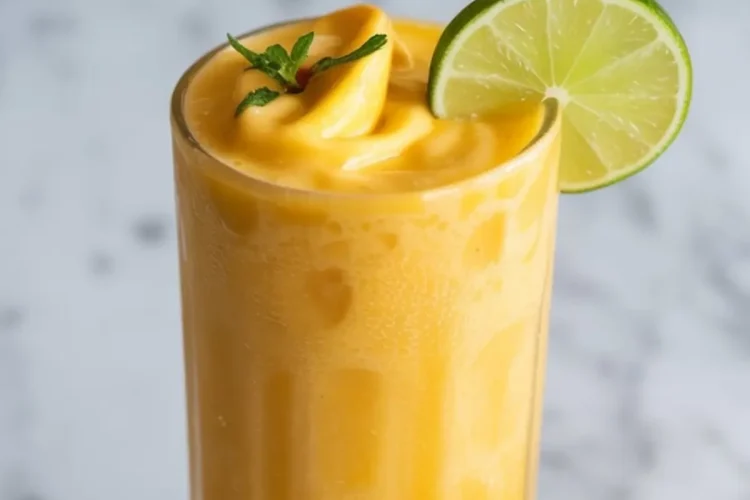There’s something satisfying about making a drink that does more than just quench thirst. This fresh mango smoothie isn’t only easy to blend, it also brings something cooling, thick, and lightly tangy to the table.
If you’ve been looking through smoothie ideas, especially mango smoothie recipes with simple ingredients, this one will hold up.
You’ll learn how to make a healthy mango smoothie that doesn’t require added sugar, includes just a few steps, and gives you flexibility in taste and texture. This smoothie fits into any smoothie diet or breakfast plan, and I’ve made it often on humid afternoons when the idea of a full meal feels like too much.
It falls into that category of sweet smoothies that also count as healthy drinks. It can lean toward dessert or serve as a light meal. This recipe covers both.

Ingredients That Build Flavor and Texture
Frozen mango chunks form the base. Their cold, firm texture helps the smoothie blend into something thick and creamy without ice. I use Ataulfo mangoes whenever I can. They freeze beautifully and give a rich, deep yellow color with balanced sweetness.
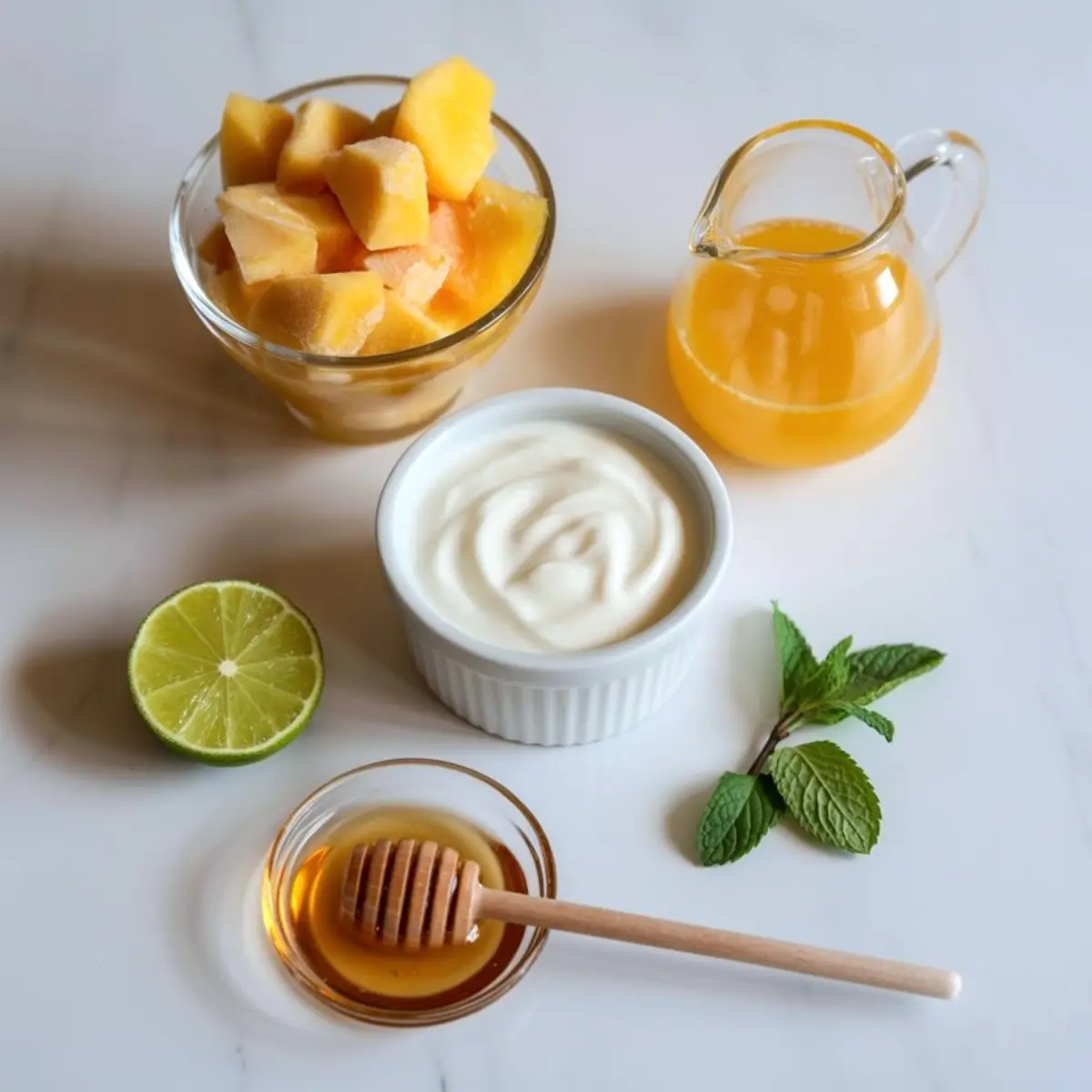
Plain Greek yogurt gives body, a clean tang, and a small hit of protein. If you’re keeping things dairy-free, coconut yogurt works equally well and adds a soft tropical finish. Either version works depending on your pantry or preference.
I often reach for orange juice when I want extra brightness and fruit-forward flavor. If I’m after something milder and creamier, I go with milk instead. Whole milk or even oat milk creates a rounder base that pairs well with tangy citrus.

A tablespoon of lime juice helps lift the entire blend. If the mango feels flat or out of season, this sharp note wakes everything up.
Quick Tip: Juice vs Milk in Mango Smoothies
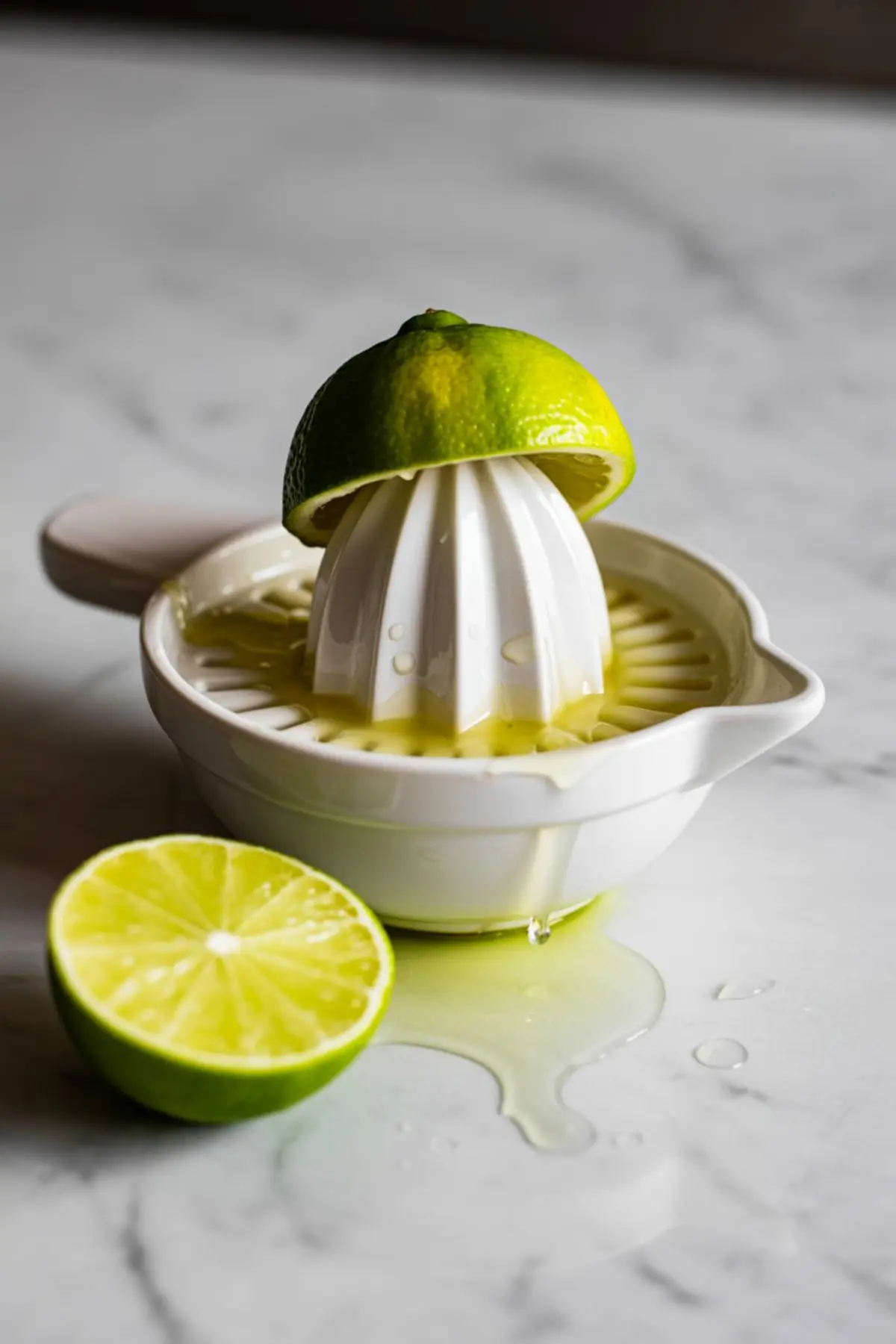
In my notes, I’ve found a meaningful difference between using orange juice or milk. Orange juice gives you a fresher, sweeter profile. Great for mornings or when the mango isn’t at peak ripeness. Milk, on the other hand, makes the smoothie rounder and softer. If you’re pairing this with a pastry or sip it as a snack, the milk version gives a more balanced mouthfeel. I’ve used both, and each has its place. Go by what you’re craving.
You can also skip added sweeteners altogether. If the mango was frozen at peak ripeness, it should hold its own. But if your batch tastes a little flat, a spoon of honey or maple syrup helps.
How to Blend It Right the First Time
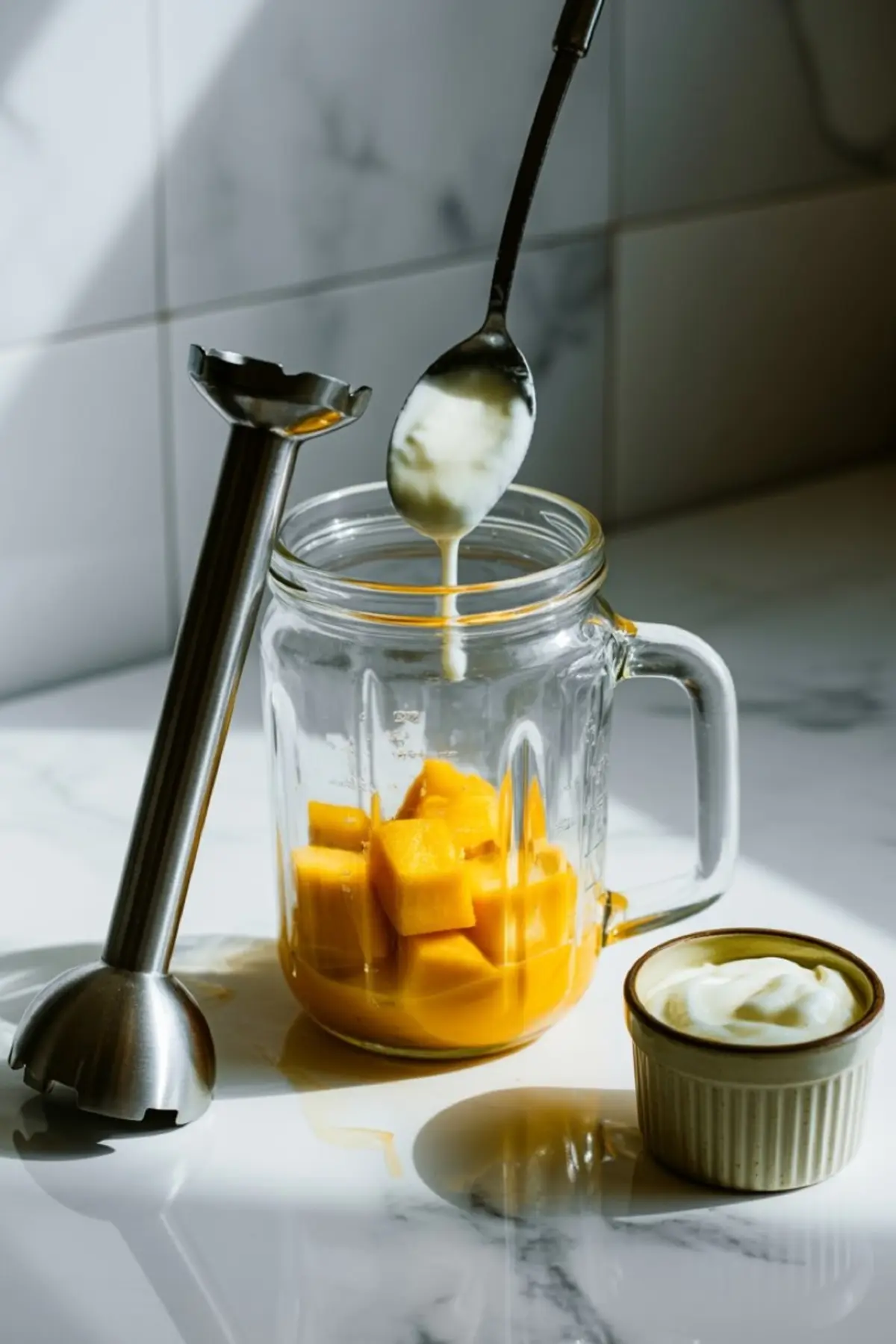
Frozen fruit takes a moment to yield to the blender blades. I let the mango chunks sit out for 3 to 5 minutes before blending. That short wait helps the machine catch and pull the fruit into the blade without needing extra liquid.
After adding yogurt, your choice of liquid, and lime juice, begin blending at a low speed. This lets the base pull down evenly. Increase to high only after the mixture starts moving well. If it locks up, pause, scrape down the sides, and add a splash more liquid.
Consistency is personal. I like mine thick enough to hold a spoon upright, but drinkable enough for a straw. If you’re making a mango smoothie bowl, reduce the liquid slightly. That gives a denser base that holds sliced toppings like kiwi, banana, or coconut flakes.
This is one of those easy smoothies that adapts well to routine. You’ll find it becomes second nature after a few rounds.
Serving Tips and Fresh Additions

Serve it cold and immediately. This fresh mango smoothie loses its texture if left standing. It’s best sipped fresh, while the yogurt still holds its chill and the mango hasn’t started to separate.
A sprig of fresh mint or a lime wedge adds contrast and a bit of brightness on the rim. For a visual boost, serve in a tall glass to show off the golden color. If you’re working on a smoothie aesthetic for social media or your own satisfaction, sprinkle chia seeds or coconut flakes on top.
You could pair this with something slightly salty, too. I’ve made this after blending Easy Mango Chia Pudding for dinner and found the cooling quality of the smoothie a helpful follow-up. The contrast works.
Storage Advice and Make-Ahead Tip
Fresh smoothies don’t keep their structure long. If you must prepare ahead, blend the mango, lime, and juice together first. Freeze this base in a jar, and add yogurt just before serving. It cuts the separation you’d get from storing a fully blended smoothie overnight.
For storing leftovers, use a sealed jar and refrigerate for no longer than 12 hours. Shake or stir well before serving again. The texture won’t match the first blend, but the flavor remains pleasant.
If you prefer a chilled dessert version, try the Mango Panna Cotta as an alternative. It holds beautifully and feels more set, like a plated treat.
Related Mango Recipes To Try Next
If you’re interested in baking with mango, the Mango Cake Recipe gives a softer sponge and brighter flavor than most fruit-based cakes.
When you’re looking for something playful and colorful, these Mango Matcha Marble Cookies bring balance with earthiness and tropical sweetness.
Each recipe uses mango in a slightly different way, which helps you keep seasonal fruit in rotation.
Save This for Later and Share Your Thoughts

This mango smoothie recipe shows that fresh, sweet smoothies can be both simple and satisfying. With just a handful of ingredients, a decent blender, and a few minutes, you can create something cold, creamy, and refreshing.
Save this recipe to your Easy Smoothies or Mango Drinks board on Pinterest so you can return to it anytime.
And I’d love to hear how yours turned out. Did you use orange juice or milk? Did you go for yogurt or keep it dairy-free? Drop a comment below and share your twist.
Mango Smoothie Recipe
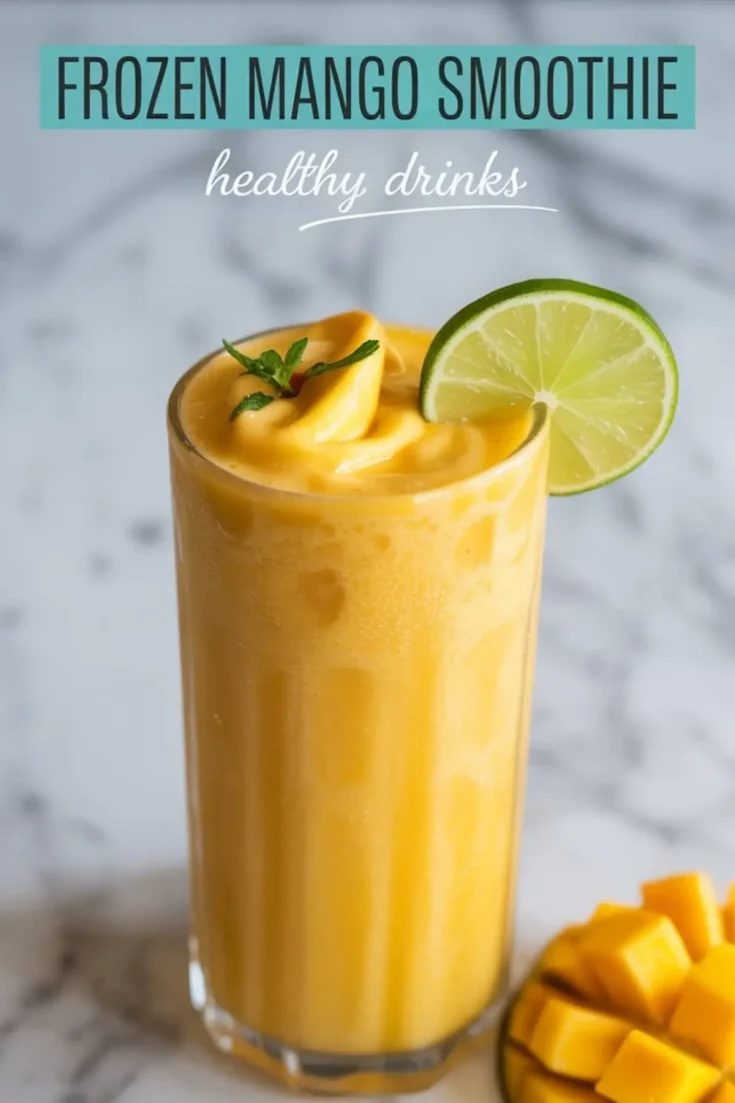
This frozen mango smoothie is thick, creamy, and naturally sweet with no added sugar. Made with ripe frozen mango, yogurt, citrus, and a splash of juice or milk, it’s quick and refreshing. Perfect as a light breakfast, post-workout snack, or a healthy dessert on a hot day.
Ingredients
- 2 cups frozen mango chunks
- ½ cup plain Greek yogurt (or coconut yogurt for dairy-free)
- ½ cup orange juice or milk of choice
- 1 tablespoon lime juice
- Optional: 1 to 2 teaspoons honey or maple syrup
- Optional garnish: fresh mint, lime wedge
Instructions
- ADD THE MANGO: Place frozen mango chunks into a blender. If they are very firm, let them sit at room temperature for about 5 minutes to slightly soften.
- ADD THE CREAMY BASE: Add Greek yogurt and orange juice or milk to the blender with the mango.
- ADD CITRUS: Pour in the lime juice to brighten the flavor and enhance the natural sweetness of the mango.
- ADJUST SWEETNESS: Taste the mango. If it’s not sweet enough, add 1 to 2 teaspoons of honey or maple syrup.
- BLEND UNTIL SMOOTH: Start blending on low speed, then increase to high. Blend until smooth and thick. Scrape down the sides if needed and add more liquid gradually if the mixture is too thick.
- SERVE: Pour the smoothie into glasses and garnish with fresh mint or a lime wedge if desired. Serve immediately.
Notes
For the creamiest texture, use very ripe mango that has been frozen in chunks. Greek yogurt adds protein and a tangy balance, but a dairy-free yogurt works well too. Adjust the liquid depending on how thick or drinkable you want the smoothie. If using juice, it will enhance sweetness; if using milk, it will make the smoothie richer. Taste your mango before adding sweetener—many ripe mangoes don’t need any added sugar.
Nutrition Information
Yield
2Serving Size
1Amount Per Serving Calories 281Total Fat 3gSaturated Fat 2gTrans Fat 0gUnsaturated Fat 1gCholesterol 13mgSodium 83mgCarbohydrates 56gFiber 4gSugar 48gProtein 12g

